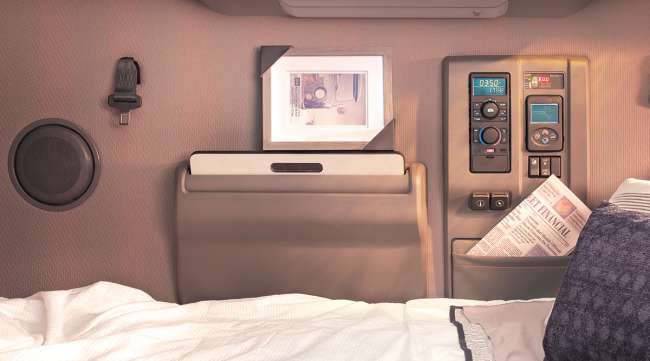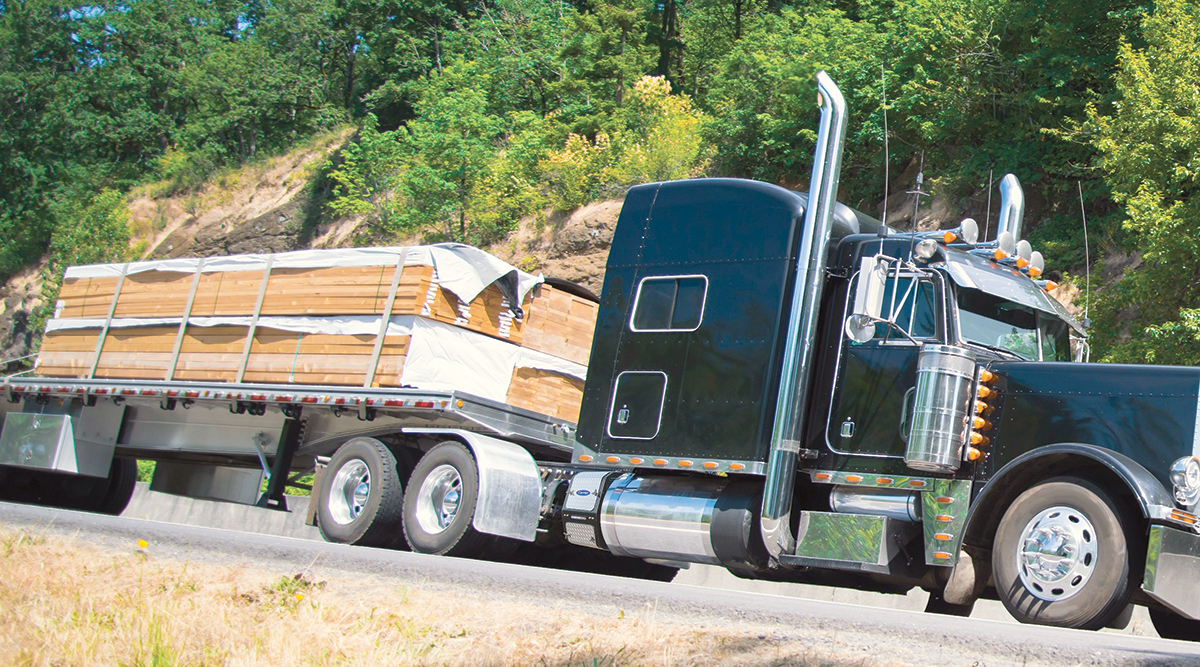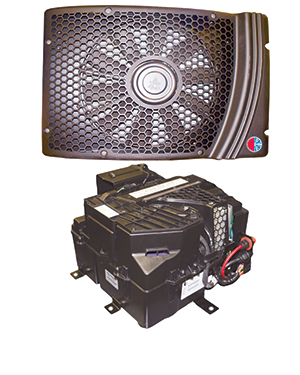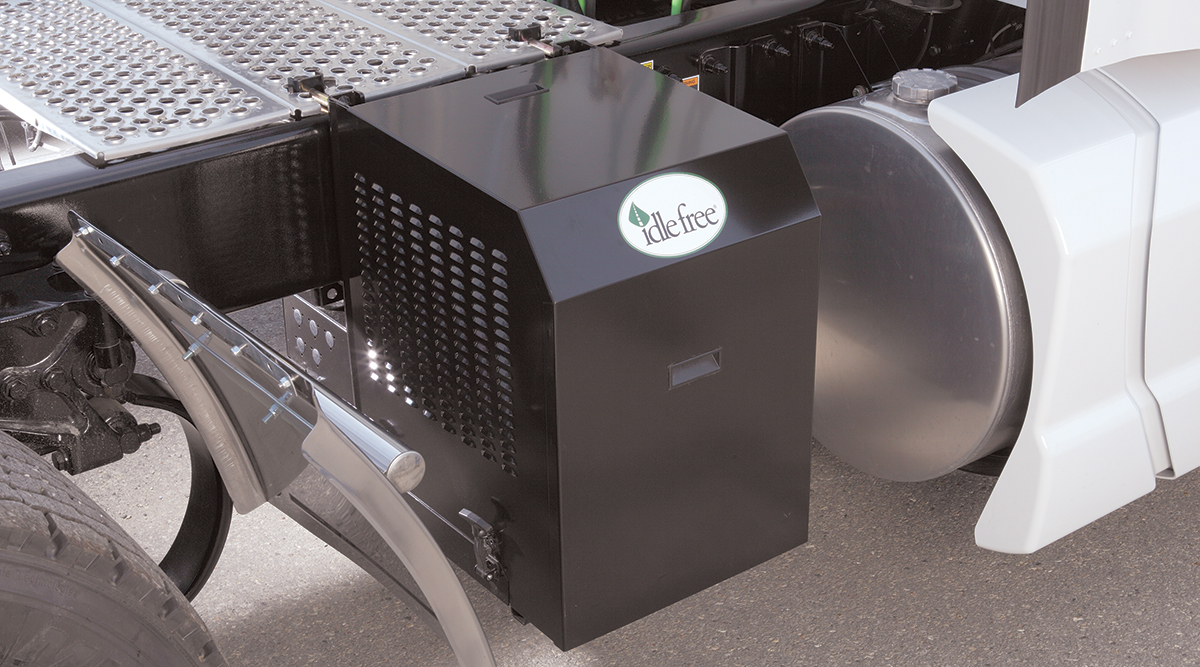APUs: Diesel or Electric?

Auxiliary power units allow truck drivers to have climate control for their sleepers and electricity for hotel loads without needing to idle the tractor engine, but fleets that elect to add APUs to the cab must decide how those APUs will be powered — by a small diesel engine or by batteries.
Central Trucking Inc., a refrigerated carrier headquartered in Edinburgh, Ind., and Paper Transport Inc., which operates out of De Pere, Wis., use electric APUs from one of the major suppliers.
“We’ve used diesel APUs, but the maintenance costs were too high,” said Mark Stahl, maintenance director at Central Trucking. “We also tried a different brand of electric APU, but the batteries didn’t last long enough to keep the air conditioning going for the full 10 hours. When that happens, the drivers understandably get upset.”

Carrier Transicold’s APU can be seen underneath the back end of the cab sleeper on this lumber truck. (Carrier Transicold)
Stahl said that the biggest payback from the APU is reducing idle time on the engine, because this “saves fuel costs, it reduces engine wear and it saves on diesel particulate filter aftertreatment costs.”
Paper Transport also is cutting costs by reducing idling, said Patrick Gray, equipment manager for the carrier. “With current fuel costs being low, the payback period is longer, but the savings are still there,” he said.
For Paper Transport, it’s not just about the fuel that is saved by reduced idling. “It’s keeping our driver comfortable in markets where it’s hot and humid,” Gray said. “The main reason for the APU is so that our drivers can have air conditioning for their breaks in hot weather without needing to idle their engines.”
There are pluses and minuses to both approaches, another industry expert said. “One benefit of diesel APUs is that they have more power,” said Sean Connell, technical director of Advanced Concepts and Electrified Products at Bergstrom.
Bergstrom offers the NITE no-idle system, which is a battery-powered air conditioner. Despite diesel APUs having more power, Connell said that many fleets prefer electric APUs “because the diesel APUs require too much maintenance and use too much fuel.”
The APU’s batteries can be used to provide electricity for hotel load devices, but when drivers need the air conditioning to last for a full 10-hour break, there may not be enough juice there.
“It’s a trade-off,” Connell said. “If you use some of the battery energy for a TV, it can affect the run time for your air conditioning. In many cases this wouldn’t matter, but in extremely hot weather, this could be an issue.”

The Nite Phoenix SSI APU from Bergstrom (Bergstrom)
Greg Bremhorst, director of sales for heavy duty and power systems for Phillips & Temro, said that it’s important to train drivers how to use an electric APU for air conditioning because taking the right steps will reduce the work required by the air conditioner.
“Simple steps to extend run time include preconditioning the cab to a comfortable temperature before turning the tractor engine off and using an insulating curtain to close off the driving area from the bunk area so that the space being cooled is minimized,” he said.
Phillips & Temro’s Idle Free Systems electric APU provides a battery-powered air conditioner, a diesel-powered heater and cab electricity with an AC outlet. It’s an “engine-off, anti-idling” product, Bremhorst said.
The diesel-powered heater warms the tractor’s engine coolant and circulates that coolant through the cab’s heater core to warm the cab, Bremhorst said. “By warming the coolant, it also warms the engine so that the engine starts easily in cold weather.”
Carrier Transicold’s ComfortPro APUs include diesel and electric models. David Brondum, a director of product management and sustainability at the company, discussed the cost comparison between the options.
“The acquisition and installation costs of a basic air conditioning-only electric APU will be less than a fully featured diesel model,” he said. “Adding options to broaden the capabilities of an electric APU will put its initial cost more in line with a diesel-powered unit.”
Even though a diesel APU uses fuel, idling a tractor engine uses much more, Brondum noted. He said Carrier Transicold’s diesel APUs will save about a gallon of fuel per hour compared with idling the truck engine. “For a truck that would otherwise idle 2,000 hours annually, the savings, at today’s fuel cost, is significant,” Brondum said.
ThermoKing also offers a diesel APU, the TriPac Evolution, and an electric APU, the TriPac Envidia. “The diesel APU would require more preventive maintenance, including oil and belt changes,” said Steve DeLarosby, ThermoKing’s APU product manager, “while the electric APU tends to cycle the batteries more frequently resulting in an increased battery replacement.”
In DeLarosby’s view, the annual average cost of operating diesel and electric APUs is about the same. The choice between diesel and electric will depend on the nature of each fleet’s business. “When purchasing an APU, it’s critical that a customer understands their needed application to ensure they have the right type of unit for their operation,” he said.
DeLarosby said that a diesel APU works best for drivers who spend significant amounts of time in either very cold or very hot environments.

The Idle Free Series 1000 from Phillips & Temro is mounted on the frame rail and provides heat, air conditioning and hotel loads. (Phillips & Temro Industries)
“For drivers who spend maybe only up to a few nights at a time on the road, use moderate amounts of electrical power for appliances and accessories, accomplish their driver reset at home, and get good amounts of drive time each day allowing them to fully recharge their APU batteries, an electric APU could be a good fit,” he said.
Driver recruitment and retention can be one reason for fleets to consider APUs. “Having an APU is becoming the expectation for many drivers,” said John Adami, principal at NW Heavy Duty. Some drivers look at the APU as a key differentiator when it comes to deciding where to work, Adami said. “If they see that a fleet has APUs, they’ll keep talking, because it’s an indicator that the fleet has the drivers’ interests at heart and cares about their comfort and well-being.”
If a fleet doesn’t have APUs, it doesn’t mean that drivers won’t drive for that fleet, but it may mean that they’ll be harder to recruit, Adami said. “Having an APU could be a tie-breaker when a driver is choosing between a fleet that has them and a fleet that doesn’t.”
Another fleet, K&B Transportation, a refrigerated carrier based in South Sioux City, Neb., uses a diesel APU from one of the major suppliers. Brock Ackerman, vice president, general manager and co-owner of K&B Transportation, said that using the APU to avoid idling brings three benefits.
“One is that not idling is better for the environment, two is that we save on fuel costs and three is that we extend the life of our exhaust aftertreatment system,” Ackerman said. “With EPA-certified engines from 2010 or later that have selective catalytic reduction, the worst thing you can do to that truck is idle it.”
“Idling clogs up diesel oxidation catalysts, and it clogs up the diesel particulate filter,” he said. “It makes a mess of your exhaust aftertreatment system.”
As for the cost of APUs, attempts to get specific prices from manufacturers weren’t successful as of press time. However, one industry representative said electric APUs range from $8,000 to $11,000 installed.
Fleets turn to APUs, in part, to comply with state and federal rules that govern idling and emissions. A variety of anti-idling laws are in place around the United States that restrict how long a truck may idle. The goal of these regulations is to reduce greenhouse gas and particulate matter emissions.
The California Air Resources Board has regulations that apply to the operation of APUs installed on trucks equipped with DPFs. If a truck engine is equipped with a DPF, then an APU on that truck also must have a CARB-approved DPF installed, said Stephan Lemieux, manager of the On-Road Heavy Duty Diesel section in the Mobile Source Control Division at CARB.
The regulations restrict only the operation of the APU, Lemieux said. The driver of a truck with a DPF on the tractor engine but without a DPF on the APU can avoid a violation simply by not using the APU while the truck is within California state lines, he said. At the federal level, the GHG Phase 2 rule identifies the use of APUs as a technology pathway for meeting the GHG standards of tractors, an Environmental Protection Agency spokesman said. Credit is given in Phase 2 for both diesel APUs and battery APUs, along with other idle reduction technologies such as fuel-operated heaters.
An APU can be added to a truck as an aftermarket purchase or ordered from the major truck manufacturers as an option on a new truck.
“Freightliner offers an optional battery powered HVAC system on both the classic and new Cascadia models,” said Kelly Gedert, director of product marketing for Freightliner Trucks and Detroit, part of Daimler Trucks North America. “When used properly, this system can provide up to 10 hours of cooling or 34 hours of heating.”
Volvo Trucks offers the Volvo parking cooler, which is a factory-installed, battery-powered air conditioning system supplied by Bergstrom, said Jason Spence, Volvo Trucks’ longhaul product marketing manager.
“The Volvo parking cooler is rated to keep the sleeper comfortable at 74 degrees Fahrenheit for up to 10 hours, even during the heat of the day,” Spence said. “The system is ideal for longhaul drivers who run their trucks at least six hours, then park for their required break.”
When fleets purchase new International Trucks, they can request an electric APU made by one of the major suppliers, said Dean Oppermann, chief engineer of advanced vehicle technologies for Navistar. “It’s not a standard feature, but it’s available as an add-on accessory.”
The Kenworth Idle Management System is a factory-installed option for the Kenworth T680 76-inch sleeper, Marketing Director Kurt Swihart said. “This battery-powered, power management system offers cab temperature monitoring, auto start and stop capability and a fuel-fired bunk heater.”
Instead of a factory-installed APU, Peterbilt offers SmartAir, its anti-idle solution. “It runs off a dedicated electrical system that charges when the vehicle is driving and allows for the system to run for 10 hours to keep the vehicle cool,” Director of Marketing Jorge Medina said.

